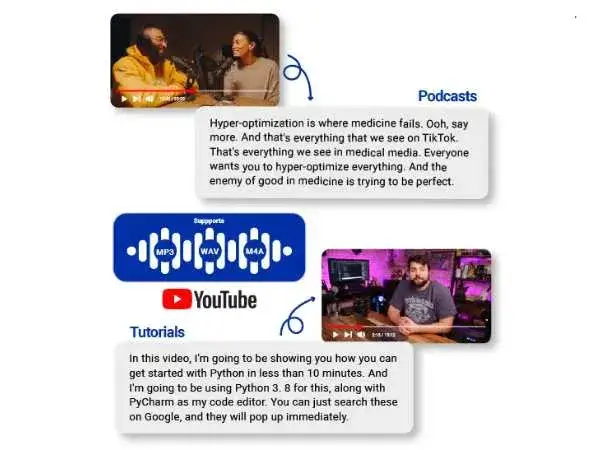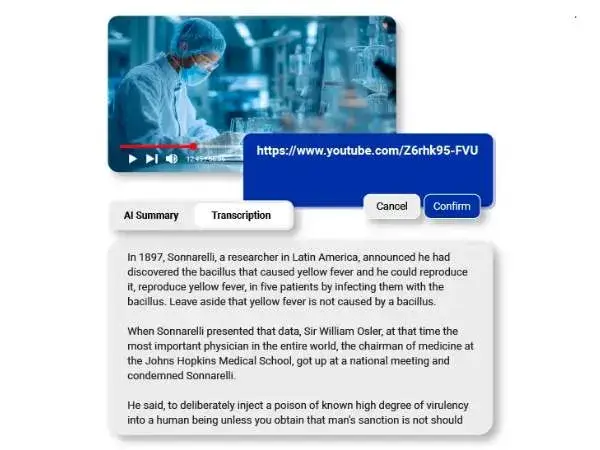
Modern professionals face an unprecedented challenge: the average knowledge worker now consumes over 2.5 hours of video content daily, with work-related videos accounting for nearly 40% of that time. Between recorded meetings, industry webinars, training sessions, and conference presentations, the sheer volume of video information has become overwhelming. Sitting through a 90-minute webinar to extract five minutes of relevant insights isn’t just inefficient—it’s unsustainable in today’s fast-paced business environment. YouTube video summarizers have emerged as powerful solutions to this information overload crisis, using AI technology to distill hours of content into digestible summaries within seconds. These tools deliver three transformative benefits: they reclaim valuable hours previously lost to passive viewing, enhance knowledge retention through structured summaries, and multiply productivity by enabling professionals to process multiple videos in the time it once took to watch one. For anyone managing competing priorities and endless content queues, video summarizers have transitioned from convenient novelty to essential professional toolkit component.
The Professional Time Crunch: Why Lengthy Videos Are Problematic
Recent workplace studies reveal that professionals spend an average of 6.5 hours weekly watching work-related videos—equivalent to losing nearly one full workday to passive content consumption. This figure encompasses recorded Zoom meetings, industry conference sessions, product demonstrations, and training materials that pile up in digital queues. The productivity drain becomes evident when considering that most professionals retain only 15-20% of information from hour-long videos watched at normal speed. The fundamental challenge lies in the linear nature of video content: finding that critical three-minute segment in a 45-minute recording requires either scrubbing through the timeline repeatedly or watching the entire piece. Marketing managers miss competitor strategy reveals buried in podcast interviews. Project leads overlook stakeholder concerns mentioned briefly in lengthy client calls. Consultants waste billable hours rewatching webinars to locate specific data points. This inefficiency compounds across teams—when five employees each spend 30 minutes reviewing the same meeting recording, that’s 2.5 collective hours consumed for information that could be absorbed in minutes through a structured summary. The consequences extend beyond wasted time: decision delays occur when executives can’t quickly extract insights from board presentations, knowledge gaps emerge when employees skip lengthy training videos entirely, and competitive disadvantages develop when industry trends discussed in conferences go unnoticed because nobody has time to watch every relevant session.

How YouTube Video Summarizers Solve Core Professional Needs
Instant AI summaries for rapid knowledge extraction
YouTube video summarizers leverage natural language processing algorithms that analyze audio tracks, identify key discussion points, and generate condensed overviews in 30-60 seconds—regardless of original video length. A 90-minute conference keynote becomes a 300-word summary highlighting main arguments, supporting evidence, and actionable conclusions. This speed differential transforms decision-making workflows: executives can review five competitor product launches before a strategy meeting instead of watching one complete presentation. Sales teams extract objection-handling techniques from multiple training videos during a single coffee break. The technology proves particularly valuable for time-sensitive scenarios where waiting hours to watch full content delays critical business responses, enabling professionals to triage information quickly and identify which videos warrant complete viewing.

Creating searchable speech-to-text transcripts
Modern transcription engines achieve 90-95% accuracy across various accents and technical vocabularies, converting spoken content into fully searchable text documents. This functionality eliminates the frustration of remembering “someone mentioned quarterly projections somewhere in that two-hour meeting” but lacking efficient retrieval methods. Professionals can now search transcripts for specific terms like “budget allocation” or “Q3 targets” and jump directly to relevant timestamps. The applications extend beyond convenience: legal teams create verifiable records of client consultations, HR departments maintain compliance documentation of training completions, and researchers catalog interview responses across dozens of subject conversations. Transcripts also accommodate accessibility requirements while serving as source material for reports, presentations, and knowledge base articles.
Effective review and share summaries for collaboration
Advanced summarization platforms include annotation capabilities that let team members highlight specific summary sections, attach comments, and flag items requiring follow-up action. A project manager can mark three critical client requirements from a discovery call summary and assign them to relevant department heads without forwarding a 40-minute video file. Sharing mechanisms integrate with Slack, Microsoft Teams, and email, delivering summaries as formatted documents rather than video links that colleagues may postpone watching. Version control features track how summaries evolve through multiple review cycles—particularly valuable when stakeholder feedback on recorded presentations requires documenting what changed between initial and final interpretations. This collaborative infrastructure transforms video content from isolated viewing experiences into actionable team resources.
Step-by-Step Guide: Implementing Summarizers in Your Workflow
Begin by evaluating platforms based on your content volume and security requirements. Browser extensions like those for Chrome offer quick access for occasional use, while API-integrated solutions suit teams processing dozens of videos weekly. Most services provide free trials—test them with actual work content rather than generic examples to assess accuracy with your industry terminology. Once selected, implementation starts with the simplest method: copying a YouTube URL and pasting it into the summarizer interface. Advanced users can configure API connections that automatically process videos added to designated playlists or shared in specific Slack channels, eliminating manual submission steps entirely. Customize output parameters to match your needs—executives might request 200-word executive summaries focusing on strategic implications, while technical teams may need detailed 800-word breakdowns preserving methodological specifics. Most platforms offer adjustable verbosity levels and topic filtering that emphasizes financial data, action items, or technical specifications. After generation, export summaries in your preferred format: plain text for email distribution, markdown for documentation systems, or PDF for formal reports. Annotation tools let you highlight critical sections and add context before sharing with colleagues. The final integration step connects summarizers to your existing workflow infrastructure. Zapier automations can route summaries directly into Asana tasks, Notion databases, or Microsoft OneNote notebooks. Establish team protocols defining when full video review remains necessary versus when summaries suffice—typically, strategic decisions warrant complete viewing while routine updates and informational content work well as summaries. Create a centralized repository where all processed summaries live with links to original videos, ensuring knowledge accessibility without requiring colleagues to recreate summaries independently.
Advanced Applications: Industry-Specific Use Cases
Consulting firms leverage video summarizers to accelerate proposal development by processing dozens of client industry webinars and competitor presentations within hours rather than weeks. A strategy consultant preparing for a retail client engagement can extract insights from fifteen conference sessions about omnichannel trends, generating comparative analyses that would traditionally require days of manual note-taking. Technology professionals use summarizers to maintain awareness across rapidly evolving domains—a software architect can monitor summarized versions of daily conference talks from multiple events simultaneously, identifying emerging frameworks and architectural patterns without attending every session. The educational sector has adopted these tools for flipped classroom models where instructors summarize lengthy lecture recordings into structured review guides, enabling students to focus study time on comprehension rather than passive rewatching. Healthcare administrators process medical training videos and regulatory update webinars through summarizers that highlight compliance requirements and procedural changes, creating reference documents for staff distribution while maintaining audit trails. Marketing teams conduct competitive intelligence by systematically summarizing competitor product demonstrations, customer testimonials, and thought leadership content—a brand manager can analyze six months of rival company video output in an afternoon, identifying messaging shifts and feature emphasis patterns. Financial analysts extract earnings call highlights and investor presentation summaries to track sentiment changes across portfolio companies without dedicating hours to full recording reviews.
Selecting the Right YouTube Video Summarizer
Accuracy serves as the foundational criterion when evaluating summarization tools—test platforms with complex industry-specific videos containing technical terminology to verify whether the AI captures nuanced concepts or produces generic overviews. Request sample outputs before committing, comparing how different services handle the same source material, particularly noting whether they preserve critical qualifiers like “projected” versus “confirmed” or “recommended” versus “required.” Integration capabilities determine whether a tool fits seamlessly into existing workflows or creates additional friction. Prioritize platforms offering native connections to your communication stack—Slack webhooks that post summaries directly into project channels, Microsoft Teams apps that process shared links automatically, or Zapier compatibility enabling custom automation sequences. Platforms like Owll AI demonstrate how AI transcription technology can handle enterprise requirements while maintaining the accuracy needed for professional applications. Security protocols become non-negotiable when processing confidential client calls, proprietary training content, or pre-release product demonstrations. Verify that platforms offer enterprise-grade encryption, comply with GDPR and SOC 2 standards, and provide options for on-premise deployment or private cloud instances that prevent sensitive data from touching public servers. Customization options separate basic tools from professional-grade solutions—look for adjustable summary lengths, topic filtering that emphasizes specific themes like financial data or action items, and output formatting that matches your documentation standards. Pricing structures vary dramatically: per-video charges suit occasional users processing five videos monthly, while unlimited subscription models benefit teams handling hundreds of recordings. Calculate your monthly video volume and multiply by per-unit costs to identify the breakpoint where subscriptions become economical, factoring in whether team seats require separate licenses or share organizational quotas.
Transform Your Video Workflow Today
YouTube video summarizers deliver measurable returns that extend far beyond convenience—professionals reclaim an average of 4-6 hours weekly by processing video content at 10-15 times normal viewing speed while maintaining comprehension of critical information. These tools have evolved from experimental novelties into indispensable productivity infrastructure, particularly as remote work proliferates video-based communication and industry knowledge increasingly disseminates through webinars and recorded presentations. Implementation requires minimal investment: most professionals achieve full workflow integration within days using browser extensions or API connections that automate content processing. Start by identifying your highest-volume video sources—recurring team meetings, industry conference archives, or training libraries—and process just five videos through a trial platform to experience the efficiency differential firsthand. The competitive landscape continues advancing rapidly, with emerging AI capabilities promising context-aware summaries that adapt to individual professional roles and learning preferences. Organizations that systematically adopt summarization technology position themselves to extract maximum value from the expanding universe of video knowledge while competitors remain trapped in linear viewing constraints. The question facing modern professionals isn’t whether to use video summarizers, but rather how quickly they can integrate these tools before the information gap becomes insurmountable.











